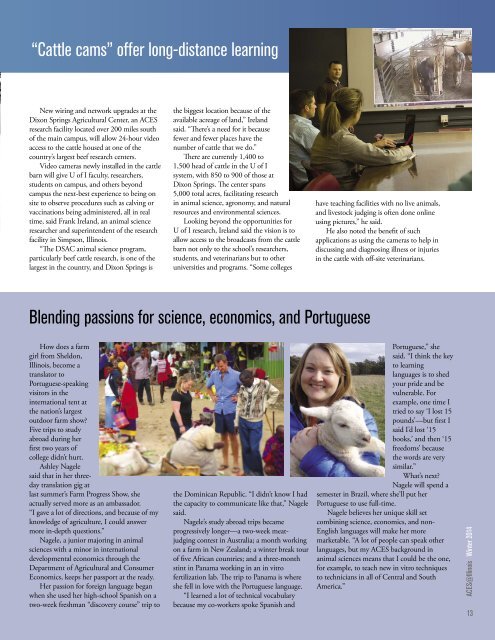t7W0J
t7W0J
t7W0J
You also want an ePaper? Increase the reach of your titles
YUMPU automatically turns print PDFs into web optimized ePapers that Google loves.
“Cattle cams” offer long-distance learningNew wiring and network upgrades at theDixon Springs Agricultural Center, an ACESresearch facility located over 200 miles southof the main campus, will allow 24-hour videoaccess to the cattle housed at one of thecountry’s largest beef research centers.Video cameras newly installed in the cattlebarn will give U of I faculty, researchers,students on campus, and others beyondcampus the next-best experience to being onsite to observe procedures such as calving orvaccinations being administered, all in realtime, said Frank Ireland, an animal scienceresearcher and superintendent of the researchfacility in Simpson, Illinois.“The DSAC animal science program,particularly beef cattle research, is one of thelargest in the country, and Dixon Springs isthe biggest location because of theavailable acreage of land,” Irelandsaid. “There’s a need for it becausefewer and fewer places have thenumber of cattle that we do.”There are currently 1,400 to1,500 head of cattle in the U of Isystem, with 850 to 900 of those atDixon Springs. The center spans5,000 total acres, facilitating researchin animal science, agronomy, and naturalresources and environmental sciences.Looking beyond the opportunities forU of I research, Ireland said the vision is toallow access to the broadcasts from the cattlebarn not only to the school’s researchers,students, and veterinarians but to otheruniversities and programs. “Some collegeshave teaching facilities with no live animals,and livestock judging is often done onlineusing pictures,” he said.He also noted the benefit of suchapplications as using the cameras to help indiscussing and diagnosing illness or injuriesin the cattle with off-site veterinarians.Blending passions for science, economics, and PortugueseHow does a farmgirl from Sheldon,Illinois, become atranslator toPortuguese-speakingvisitors in theinternational tent atthe nation’s largestoutdoor farm show?Five trips to studyabroad during herfirst two years ofcollege didn’t hurt.Ashley Nagelesaid that in her threedaytranslation gig atlast summer’s Farm Progress Show, sheactually served more as an ambassador.“I gave a lot of directions, and because of myknowledge of agriculture, I could answermore in-depth questions.”Nagele, a junior majoring in animalsciences with a minor in internationaldevelopmental economics through theDepartment of Agricultural and ConsumerEconomics, keeps her passport at the ready.Her passion for foreign language beganwhen she used her high-school Spanish on atwo-week freshman “discovery course” trip tothe Dominican Republic. “I didn’t know I hadthe capacity to communicate like that,” Nagelesaid.Nagele’s study abroad trips becameprogressively longer—a two-week meatjudgingcontest in Australia; a month workingon a farm in New Zealand; a winter break tourof five African countries; and a three-monthstint in Panama working in an in vitrofertilization lab. The trip to Panama is whereshe fell in love with the Portuguese language.“I learned a lot of technical vocabularybecause my co-workers spoke Spanish andPortuguese,” shesaid. “I think the keyto learninglanguages is to shedyour pride and bevulnerable. Forexample, one time Itried to say ‘I lost 15pounds’—but first Isaid I’d lost ‘15books,’ and then ‘15freedoms’ becausethe words are verysimilar.”What’s next?Nagele will spend asemester in Brazil, where she’ll put herPortuguese to use full-time.Nagele believes her unique skill setcombining science, economics, and non-English languages will make her moremarketable. “A lot of people can speak otherlanguages, but my ACES background inanimal sciences means that I could be the one,for example, to teach new in vitro techniquesto technicians in all of Central and SouthAmerica.”ACES@Illinois Winter 201413


